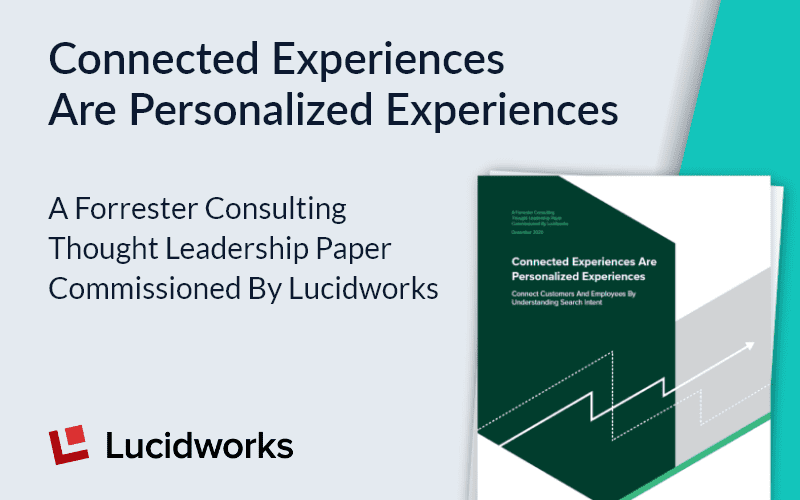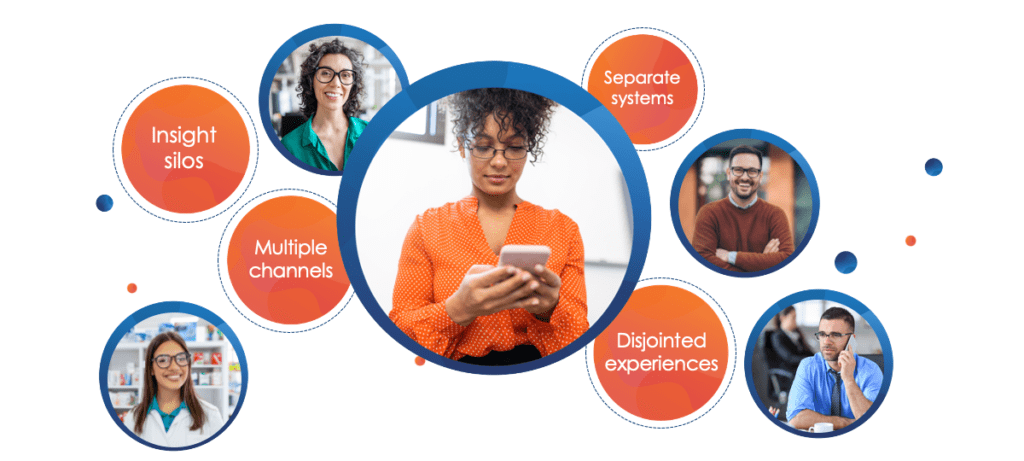New Study: Why Brands that Connect Experiences Win
A recent Forrester study found that companies are struggling to implement omnichannel personalization. Brands that are able to connect EX with CX report greater revenue, operational efficiency, and customer satisfaction.

Omnichannel personalization remains a top priority for brands. However, two-thirds of respondents in a new commissioned study conducted by Forrester Consulting reported that they could not consistently service customers across touchpoints and personalize their experiences. Although brands have a vision for omnichannel personalization, they’re still getting tripped up by data silos, technology limitations, and old habits.
The study, “Connected Experiences Are Personalized Experiences”, confirmed that companies that are able to connect employee experience (EX) with customer experience (CX) improve both. Companies that understand real-time intent from customer search and browse to personalize an experience within that moment gain quantifiable business benefits.
- More than 50% more likely to report revenue growth
- More than 40% more likely to report innovation
- Almost 30% more likely to report operational efficiency
Connecting employee and customer experiences is a clear path to omnichannel personalization and overall business success.
“The study findings mirror those we see in our own customer base with clients such as Morgan Stanley and SAS. Enterprises who connect search and knowledge management experiences across channels consistently outperform those who don’t. Our customer Lenovo saw conversions increase by 35 percent after they began capturing customer signals and applying those insights to their business.” -Will Hayes, Lucidworks CEO
Omnichannel Personalization Is (Still) Difficult to Achieve

Let’s forget about ‘personalization’ as a buzzword for a second and just focus on what brands mean when they aspire to ‘omnichannel personalization’. Brands want the experience for the user to be personalized no matter what channel they’re reaching out on. Support should be familiar with my purchase history and issues, the mobile app should know what kind of products I’m looking for, and the website should welcome my return with personalized recommendations.
Almost every respondent in the Forrester survey reports having data-related challenges serving customers over digital channels. And a majority of survey respondents say they are not using data from individual Voice of the Customer channels for strategic decision-making.
At the end of the day, brands want to get the most out of their technology investments and empower employees with the best information available in real-time so they can create a phenomenal customer experience that improves customer loyalty. All while driving revenue growth, customer satisfaction, and operational efficiency.
Now that we’re all on the same page–omnichannel personalization is critical but difficult–how do we get there?
Connected Experiences Are Personalized Experiences

For years, customer experience (CX) has taken priority over employee experience (EX), but companies are increasingly discovering a connection between better EX and improved CX. This should not be surprising. After all, companies hire employees to serve customers. By design, they share millions of experiences every day, and engaged employees, on top of being more productive and higher performing, deliver better customer experiences. This study shows what we hear from our customers: companies want to capture signals from users anywhere and apply those insights to experiences everywhere.
|
The study calls out enterprise search as a use case for connected experiences. Strong customer search delivers results that are personalized and demonstrate an understanding of customers’ intent. Enterprise search helps employees do their job faster, more effectively and with greater satisfaction. However, it is the connection between customer search and enterprise search, using signals and insights from one to feed the other, that empowers employees and delights customers.
The proof we see in the study is in line with improvements our customers experience every day with the Connected Experience Cloud. For example, our customer Lenovo was trying to improve the digital experience for their online shoppers. The missing puzzle piece was putting valuable customer behavior data in the hands of employees who are making strategic decisions about CX — connecting EX with CX. When employees can come to the table with an understanding of how customers use your platform (in this case, insights into how they search and browse) they have more information to make better strategic decisions — which is great for improving both EX and CX. After Lenovo deployed Fusion, they saw a 35% increase in their online conversion rate.
Five Attributes Underpin Connected Experiences
The Forrester survey uncovered five key business capabilities that, taken in concert, enable businesses to deliver connected experiences. We list these attributes separately and assign some benefits to each. However, it’s very important to remember that the effects of each compound one another. Lucidworks’ customers enjoy the compound benefit of enjoying these five capabilities as part of an integrated platform.

- Real-Time Personalization: The Forrester study shows highly connected companies are 40 percent more likely to use real-time intent to personalize experiences in the moment. One Lucidworks customer is a leading retailer who uses Fusion to deliver signals-based personalization, which increased annual revenue by $10 million.
- Harnessing Customer Signals: The Forrester study shows that the lack of signals from customer behavior, as well as an inability to derive insights from signals, were two of the top five challenges identified by respondents seeking to personalize customer experiences. Lucidworks discovered that one of our customers, a leading department store, saw a 50 percent increase in conversions by capturing signals and applying insights in real time to optimize the shopper experience.
- Understanding Intent: The Forrester study shows an overwhelming 97 percent of respondents have challenges understanding customer intent. Lucidworks saw one of their customers, a leading provider of open-source software solutions, use signals-based intent detection on their customer support portal to improve customer self-solve rates by 300%.
- Cross-Channel Delivery: According to the Forrester survey, without a coordinated cross-channel strategy, creating relevant experiences that span the customer’s journey is nearly impossible. We found that one of our customers, an enterprise data management firm, saved over $5M in costs after deploying signals-based personalization across multiple support channels.
- Machine Learning (ML): According to the Forrester study, 40 percent of respondents cite a lack of machine learning as an obstacle to understanding customer intent. However, when brands deploy ML they can realize major benefits. One Lucidworks customer, a major home goods retailer, deployed Fusion’s out-of-the-box ML to improve the shopper experience, resulting in $200 million in organic annual growth.
Build Your Unique Connected Experience Cloud

You must have all five capabilities working in concert to allow employees and customers to interact with each other using the full intelligence of all past interactions before you can reap the sweet rewards of connected experiences. If you’re interested in nailing omnichannel personalization, delighting customers, and empowering employees reach out to us today.
Check out this CXC video to see how the Connected Experience Cloud meets the intent of customers and employees and download “Connected Experiences Are Personalized Experiences” today.
LEARN MORE
Contact us today to learn how Lucidworks can help your team create powerful search and discovery applications for your customers and employees.